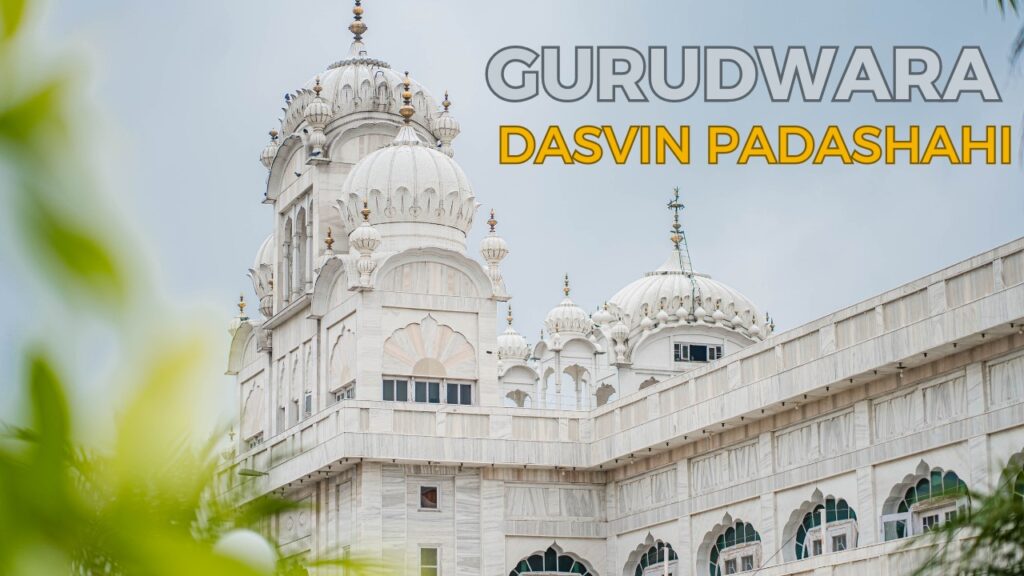The Gurudwara Dasvin Patashahi is located in the quiet town of Nadaon in Una district of Himachal Pradesh. It is of immense architectural, historical and spiritual significance to members of the Sikh community. The sacred place of worship, associated with the 10th Sikh Guru Guru Gobind Singh Ji, is now a famous pilgrimage site and a landmark for Sikh heritage and culture. Nadaun is located just 55 km from Una, the city closest to the Una-Kangra highway. Nadaun Kangra is only 47 km away, while Dharamsala is only 64 kilometers away.
Historical importance
The Dasvin Patashahi Gurudwara is located in the town of Nadaun in the Hamirpur district of Himachal Pradesh. The Gurudwara, also known as Khalsa Patashahi, is located on the banks of the river Beas and is a well-known place of worship. At this sacred place, Guru Gobind Singh “with the support of Raja Bhim Chand of Kahlur and other hill chiefs fought against the Mughals in a fierce battle, the “Battle of Nadaun”. The Mughals were ordered by their governor of Jammu, Miari Khan, to collect taxes to fund Aurangzeb’s Darbar from the hill rajas in 1687. The funds were needed by Aurangzeb’s army to defeat the Marathas in the Deccan.

Battle of Nadaun
The famous battle took place on March 20, 1691. Alif Khan was defeated and was forced to retreat, leaving behind his camp and supplies of ammunition, weapons and other important items. After the battle, Guru Gobind Singh stayed in a shrine in Nadaun for eight hours. Then Maharaja Ranjit Singh built a Gurudwara near the place where the Guru had pitched his tent. The Gurudwara is also known as Gurudwara Nadaun Sahib. The present Gurdwara Dasvin Patshahi has replaced the earlier Gurdwara built under Maharaja Ranjit Singh. Gurdwara Dasvin Patashahi is not only a tribute to Guru Gobind Singh Ji, but also of great significance to the Sikh community in general. It is an opportunity to remember the sacrifices made by Guru Gobind Singh Ji and the ideals of equality, justice and selfless service taught by him.
Architecture : Gurudwara Dasvin Patashahi
The architectural style of the Gurudwara Dasvin Patashahi is a combination of traditional Sikh and modern styles. The layout and design of the Gurudwara reflect the sanctity and religious significance associated with Sikh prayer temples. The magnificent structure, adorned with intricate artwork and decorative details, creates an atmosphere of awe and wonder in the eyes of the people who visit it.
Inside the Gurudwara are exquisite paintings, frescoes and other decorative elements that tell stories of the Sikh past. The ponds, which are sacred, and the manicured gardens that surround the Gurudwara add to the tranquility and serenity of the place.
Spiritual Significance
The Gurudwara Dasvin Patashahi serves as a place of worship and rituals appropriate for members of the Sikh community. People dedicated to the Sikh religion gather at the shrine to pray, practice kirtan (spiritual singing of hymns), and participate in the recitation of sacred scriptures, which include those of the Guru Granth Sahib. The atmosphere is full of reverence and devotion, resulting in a highly spiritual experience for guests.
The Gurudwara has a special significance during Prakash Divas, the birthday of Guru Gobind Singh Ji. The festival is marked by religious processions, lectures on Sikh philosophy and history, and dazzling displays of the Sikh martial arts known as gatka. A large number of devotees from all over India and the world are expected to attend the celebrations to receive prayers and pay their respects to this auspicious day.

Gurudwara Dasvin Patashahi is also known for its community activities. The organization runs a langar, a community kitchen where free meals are provided to all, regardless of religion, caste or social status. The selfless practice, known as seva, is rooted in Sikhism and reflects the core values of love and equality.
Promoting Cultural Heritage
In addition to its religious significance, the Gurudwara Dasvin Patashahi plays a vital role in preserving and promoting Sikh cultural heritage. The Gurudwara actively participates in cultural events such as worship services, religious discussions, and educational activities to instill Sikh values and beliefs in younger generations.
The Gurudwara also actively participates in social welfare initiatives and offers support to the community at large. Through initiatives such as blood donation camps, medical camps, and scholarships for education, the Gurudwara expands the scope of its offerings to people outside its religious boundaries and contributes to the overall development of society.
Tourist Attraction
Gurudwara Dasvin Patashahi has become one of the most popular pilgrimage destinations, attracting tourists and devotees from all over the world. The tranquil setting, architectural splendor and spiritual ambiance make it a must-see for those seeking peace and a deeper connection to Sikhism.
How to Reach Gurudwara Dasvin Patashahi
The Gurudwara is easily accessible by highway and has good connectivity to the major cities of Himachal Pradesh. Adequate parking facilities and accommodation nearby ensure a pleasant stay for the tourists. Moreover, Nadaon is a picturesque town. Nadaon offers breathtaking views of the Himalayan landscape and serves as a base for other popular destinations in the region.
Conclusion
The Gurudwara Dasvin Patashahi in Nadaon, Himachal Pradesh, is a symbol of the rich Sikh tradition and teachings imparted by Guru Gobind Singh Ji. Its architectural, historical and spiritual significance combined with its dedication to community service make it a place of reverence for Sikhs and a captivating destination. A visit to this sacred gurudwara is a unique opportunity to learn about the Sikh tradition, see the architectural wonders of the site, and find some peace and tranquility in the surroundings.
Suggested Reading:
Recent Posts
- Camping at Chandertal Lake, Himachal Pradesh: A Complete Guide
- Exploring Keylong: Your Ultimate Travel Guide
- Delhi to Manali Bus Journey: A Traveller’s Guide
- Bhrigu Lake Trek: A Himalayan Adventure from Ahmedabad
- Hampta Pass Trek: A Journey from Ahmedabad to the Himalayas
- Gobind Sagar Lake
- Chamba, Himachal Pradesh: A Comprehensive Travel Guide











